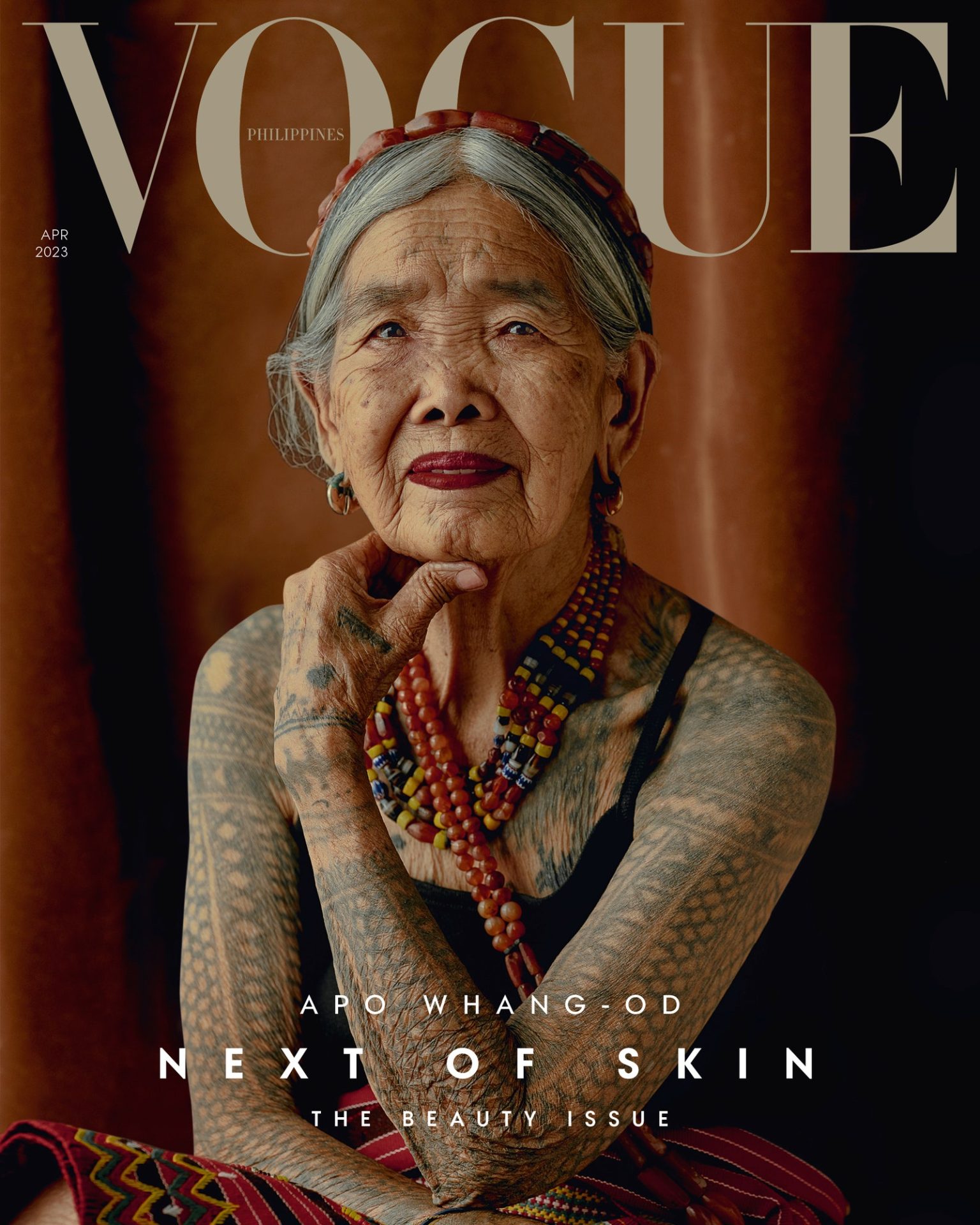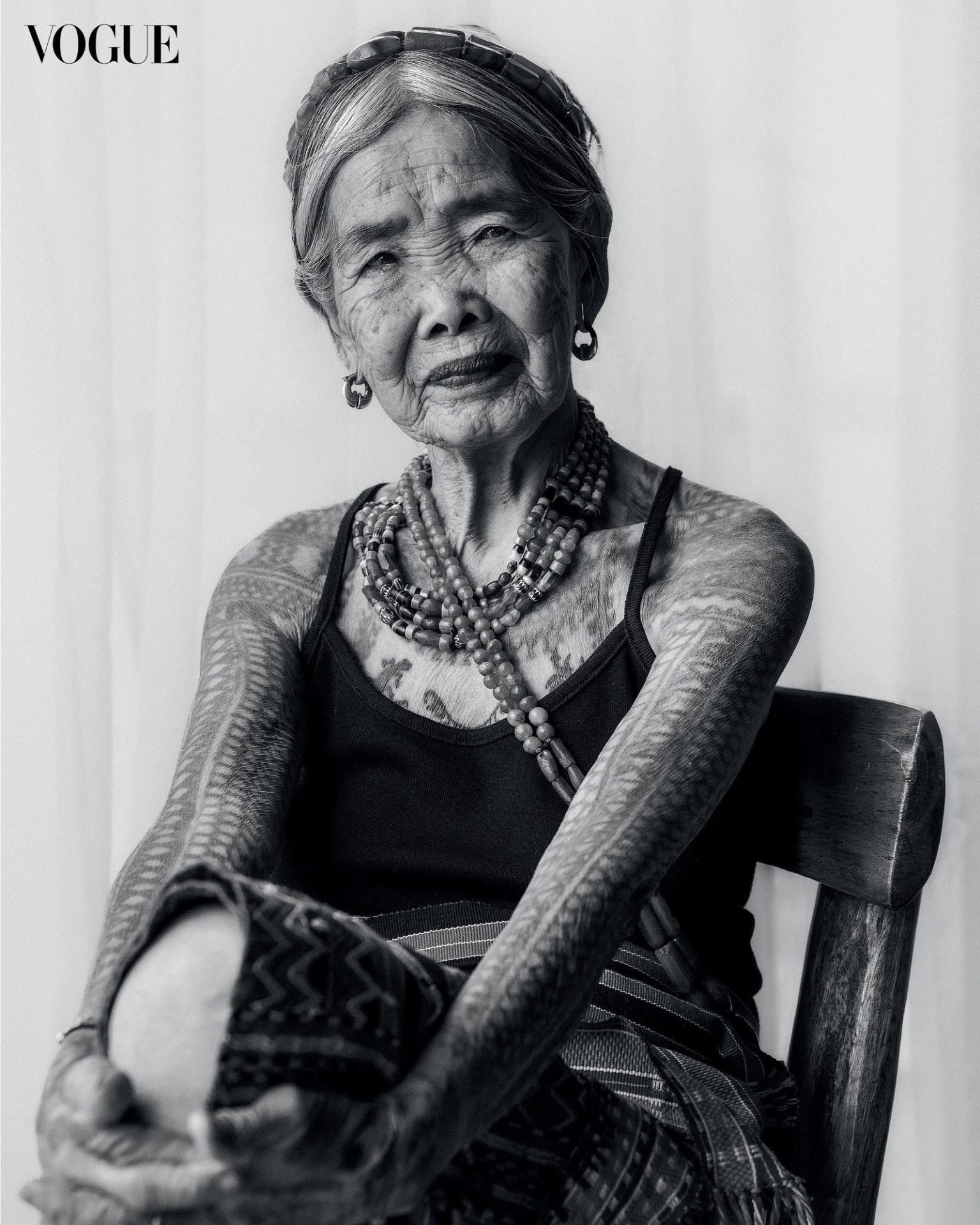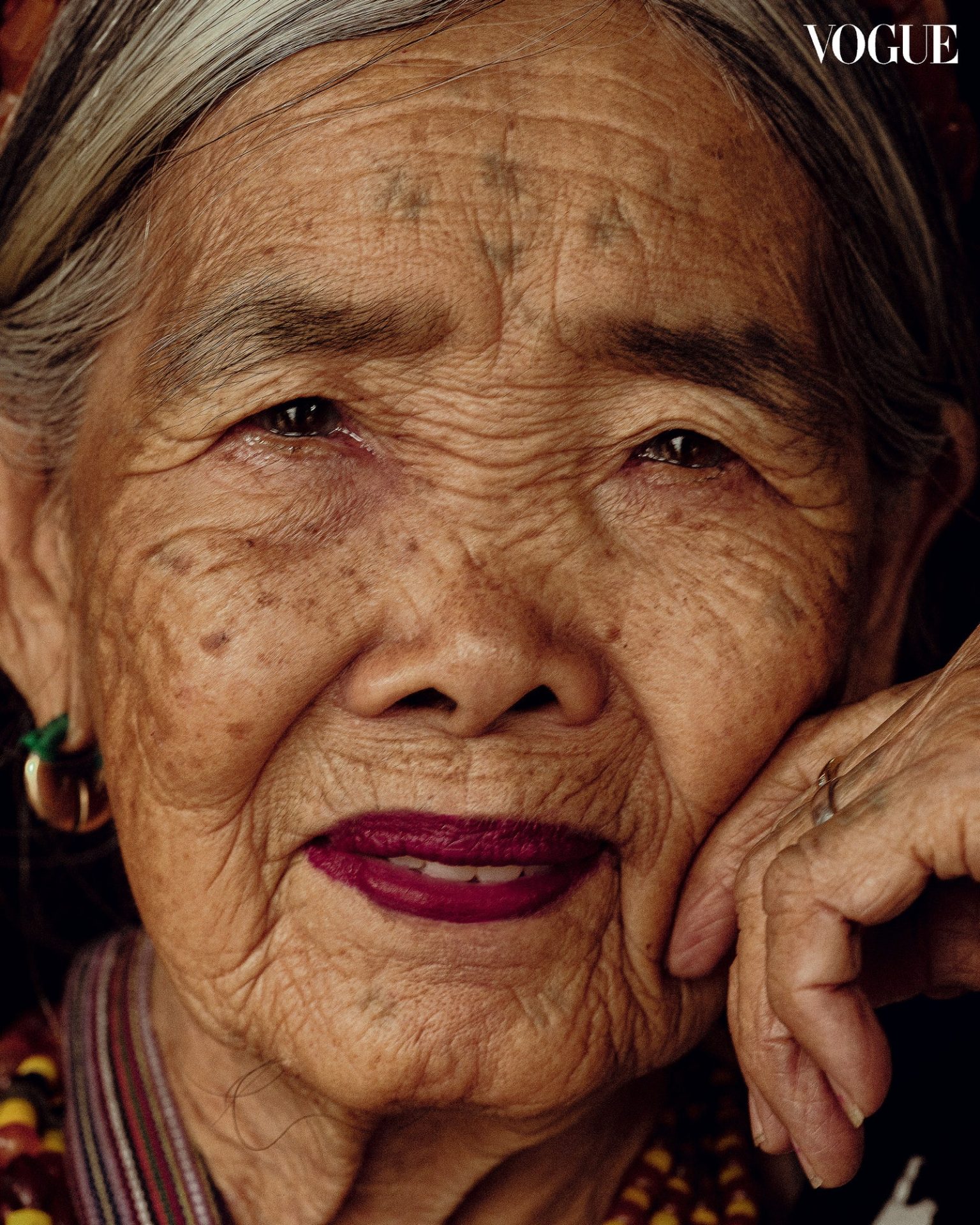The thousand-year-old practice of batok will live on, in Buscalan and around the world, thanks to the descendants whom Apo Whang-Od has been training and inspiring.
The remote village of Buscalan, home of the famed last mambabatok of her generation, has never been this accessible. Sure, you still need to endure the 12 hour-body-numbing drive from Manila with its city gridlock to the winding mountain roads of the Cordilleras, swerving around landslide debris and oncoming trucks in dangerously foggy conditions. But the dirt path from the turnoff in the municipality of Tinglayan, Kalinga — clearly marked by a sign that proclaims Welcome! Whang-Od Buscalan Tattoo Village — is now paved over, reducing hike time by over an hour. What’s left is a strenuous climb through the rice terraces that a reasonably fit person can conquer in 40 minutes.
The woman who has been around to witness all these changes is also the one largely responsible for them. Apo Whang-Od, the sprightly centenarian also known as Maria Oggay, has been hand-tapping tattoos on skin since she was a teenager. It was only within the last 15 years or so that her clientele — and her renown – exploded beyond the Cordillera region, with thousands of visitors coming from all over the world, all seeking the exquisite pain of the soot-stained thorn.

According to lore and to interviews conducted by tattoo anthropologist Dr. Lars Krutak, Whang-Od was 16 when she began her career as a tattooist under her father’s mentorship. The first and only female mambabatok of her time, Whang-Od would travel to far and neighboring villages, summoned by host communities to imprint the sacred symbols of their ancestors on individuals who have crossed or about to cross a threshold in their lives.
For men, this meant being minted as a headhunting warrior. A bikking, a chest tattoo with patterns that crawled up the shoulders and down the arms, could take days to finish and would cost a large pig or several kilos of rice. Women were tattooed for different reasons, primarily for fertility and beautification. The tattooed elder women of Kalinga often say that when they die, they can’t take their beads and gold with them to the afterlife. They only have the markings on their body.
Whang-Od has tattooed more women than warriors, as headhunting was banned by the Americans in the early 1900s. The image of the Kalingas as bloodthirsty savages was perpetrated by the colonial ethnologic photographer Dean Worcester, who in 1912 published photographs of Cordilleran tribes in National Geographic, describing them as both exotic and terrifying in an attempt to justify American control of Northern Luzon, or what he called “No Man’s Land.” But reality was more nuanced. Headhunting, as practiced, was a part of ritual warfare that had spiritual implications. Cultural tattoo practitioner Lane Wilcken explains in the book Filipino Tattoos: Ancient to Modern (2010) that headhunting functioned to restore the balance and justice between communities in conflict. The marking of the warrior was thus a ceremonial and sacred activity, done in several stages over almost two years.
In those days, unmarked women were considered imperfect, undesirable. One of the most enduring ullalim, a form of epic poetry that is chanted by the village bard, is the story of the warrior hero Banna who falls in love with the beautiful Lagunnawa. In the pre-colonial tale, their tattooed bodies are celebrated as badges of honor, wealth, beauty, and bravery.

On Whang-Od’s skin is inscribed her life story, from accomplishments to ailments and names of long-gone lovers.
When the American Catholic missionaries came and built schools in Kalinga, village girls were made to cover their arms with long sleeves. Being tattooed became a point of shame when women ventured to the city, and eventually fewer girls from the succeeding generation continued the tradition as Western concepts of beauty and respectability began to permeate the culture.
“Traditional tattooing is seen as archaic and painful by the younger generations of the tribe,” wrote Kalinga elder and former NCIP official Natividad Sugguiyao in the intro to photographer Jake Verzosa’s The Last Tattooed Women of Kalinga (2014). “Though the practice has completely ceased, it remains vital that it should never be forgotten.”
The practice may have died out among the Kalinga, but outside forces have again exerted their influence, this time in helping revive the practice of batok and transforming it into something of a hybrid artform. In 2007, Dr. Lars Krutak spent two weeks in Buscalan filming the Philippine segment of his Discovery Channel series Tattoo Hunter. There he met Whang-Od, who was nearly 90 at the time and still working the rice fields every day.
Mambabatok can only pass on their craft within their bloodlines, and Whang-Od never had any 𝘤𝘩𝘪𝘭𝘥ren of her own. Grace Palicas, her 10-year-old grandniece, was chosen to be her apprentice, though initially a reluctant one.
“I was the first 𝘤𝘩𝘪𝘭𝘥 to learn how to tattoo. I just observed what she did,” Grace, now 26, tells us. “When I left for college in 2015, Elyang was next to learn so that she could help Apo when so many tourists were coming.”
We are at Grace’s house, where she and her 23-year-old cousin Elyang Wigan have been tapping ink into the limbs of a handful of visitors who arrived in Buscalan that morning. Afterward, the newly inked will walk a few houses down to where Whang-Od holds court to get her signature three-dot signoff, the only tattoo she does nowadays. Getting the dots, which takes all of five minutes to complete, has been described as more painful than the larger pieces done by the lighter hands of Whang-Od’s protégés. But what is pain, or the risk of a small infection, when you’ve made it all the way here to see the living legend in the flesh?
We find Whang-Od by her house, sitting on a low footstool on the dirt floor, preparing her tools to dot a client on his arm. She is dressed in her usual “accidental hipster grandma” style, wearing a puffy bomber over track pants and a paisley bandana around her forehead. The outer walls of Oggay’s home are covered with tour group-sponsored tarps of her likeness, a reminder of the transactional, touristy nature of this exchange. We are, after all, neither warriors nor Butbut maidens ready for marriage. It is an honor for outsiders like us to be given these sacred markings, one we do not deserve.
When she finishes with the client, it is the Vogue team’s turn to get tatted. First is Sela Gonzales, the photographer’s assistant and the only one of us who could communicate with her in Ilocano (Whang-Od doesn’t speak Tagalog or English). An aide procures an unused gisi, a bamboo stick with a thorn attached to one end, while Whang-Od traces the pattern on Sela’s arm using a length of grass dipped in the soot and charcoal mixture. Holding the inked gisi in her left hand, she uses a larger stick to whack it with her right hand, driving it over a hundred times per minute into the flesh until the three dots are filled and oozing with blood and ink. She dabs at them with a wet wipe before deciding to go over the freshly wounded spots again for good measure. Aray.
“When visitors come from far away,” Whang Od says in the Butbut language, “I will give them the tatak Buscalan, tatak Kalinga for as long as my eyes can see.”
In the fall of 2022, Grace spent several weeks in France, where her husband is from, and where she was invited as a guest tattoo artist at a few different tattoo studios. Grace is the first Buscalan native to bring batok to the West. Her clean, symmetrical black lines are impressive; patterns of scorpions, centipedes, snakes, and rice bundles come together to form a large tapestry running down the length of an arm or leg. One of her clients, a hand poke tattoo artist from Brooklyn, commented on Instagram that it was truly her most meaningful tattoo experience. A Philippine indigenous practice that was on the verge of being lost to history is being inscribed on new skin. The stories of the Butbut people and their beliefs will continue to be passed along through the vector of a thorn, plucked from a tree grown in Kalinga soil.
Traditionally, ceremonial rituals accompanied the tattooing, and they ranged from the chanting of an ullalim or the sacrificing of a chicken. These days, the performance of rituals is altogether left out of the tattoo session, although Grace says that they can be done if requested, especially upon the completion of a large, multi-day tattoo. For non-natives, the tattoos are pretty much divorced from their ancestral context, chosen from the same limited menu of designs offered to everyone. In the end, we assign our own meanings to them, reading the symbols through the lens of an individual and not the community.

Apo Whang-Od with grand-niece Grace Palicas, who has inherited her commitment to the craft of batok.
I was relatively uninformed when I got my first Kalinga tattoo a year before. If you asked one of the mambabatok there what a particular design meant, you’d get a vague answer that was some combination of “guidance, strength, and protection.” I had chosen the crab/traveler partly because I associated it with my family and partly because I had read somewhere that it was one of the original Kalinga patterns, compared to the sun/moon motifs, which were new-generation designs by Whang-Od and Grace. Later I learned that the crab design with its pincers/fishhooks is associated with the Filipino deity Lumauig. A few scholars have noted that Lumauig bears a striking resemblance to the Polynesian trickster Maui. As you probably know, Maui possesses a magical fishhook. I regarded my tattoo with a new appreciation of the deep intertextual history behind its simple lines.
Emily Oggay, a relative of Apo, tattooed the crab on my thigh. It was virtually painless. She joked that her taps are like tik-tik-tik while Apo’s taps are TOK-TOK-TOK, miming a heavy hammer. Like Grace and Elyang, she is part of the new generation of mambabatok—and there are surprisingly many, mostly girls and women. I counted at least 18 Gen Zers who had picked up the craft through observation and practicing on themselves and each other. Many of them started in 2018 after seeing the tourism boom and the long lines of travelers waiting all day for a session with Apo. At its peak, Buscalan hosted over 400 visitors a day. Tour groups by the van loads were hauled to the mountain, some guaranteeing a meeting with Whang-Od, like she was a whale shark to be sighted. Homestays were crammed to the brim, with strangers sleeping shoulder-to-shoulder on the floor. Even if Whang-Od were to perform the full ritual for all her visitors, there wouldn’t be enough chickens to sacrifice.
“Before, farming was our livelihood. We would only eat kamote. You can see how tourism changed Buscalan when visitors started coming,” Grace says, translating what Apo was saying. She describes how they started to eat a variety of food, and how locals took new jobs as tour guides and homestay operators. “We also learned how to speak English and Tagalog because of the visitors.”
This all came to a grinding halt during the pandemic when Buscalan was completely closed to visitors for two years. Villagers had no choice but to return to farming. Grace adds that “it was also good because we were able to rest a bit.” But when I first went up in July 2021, Whang-Od was not at home resting. She had absconded to the village in the neighboring mountain where restrictions were laxer. She wanted to keep tattooing.
I had found Whang-Od, gangster as ever, hanging out by a giant golden statue of herself, under whose outstretched arms and bare breasts I received my three dots.
Jake Verzosa recalls the time he first got a tattoo from Whang-Od. The year was 2009, and he paid for his markings in brown sugar and posporo. “When Whang-Od started getting tired after tattooing for a few hours, Grace would take over,” he tells me. Indeed, the cuff on his arm starts off a bit crooked. Grace would have been 13 at the time, but “her lines were very clean.” Growing up in Tuguegarao, Jake would see the tattooed elders near his school and would often hear stories about Buscalan. It was not an easy trek to make, and at the time it was mostly foreigners who happened upon the village. Jake would spend three years completing his portrait series of the women elders of Kalinga. His iconic black-and white image of Whang-Od, which has been exhibited all over the world, can be found in various permutations all over Buscalan. 
Whang-Od was conferred the Dangal ng Haraya award in 2018, and the campaign is still on to raise her to a National Living Treasure or even a National Artist.
Whang-Od’s face is also plastered on all kinds of merch from t-shirts to coffee packaging, and that’s just in Buscalan. I don’t know if it’s because of her guilelessness and genuine desire to share her culture, but she has been at the center of several incidents that have been called out as exploitative, with a few requiring the National Commission on Indigenous Peoples to step in as the gatekeepers of indigenous intellectual property rights.
At a webinar that discussed these issues, social anthropologist Dr. Analyn Salvador-Amores noted that what was once a place-based ritual has been transformed into a commercialized practice. “Culture is an increasingly prized commodity, aggressively appropriated by other entities,” she said. “Instead of asking who owns culture, we should ask how we can promote respectful treatment of native culture and indigenous forms of self-expression within mass societies.”
Whang-Od, who turned 106 in February, is the oldest living mambabatok but certainly not the last. The three dots representing Apo, Grace, and Elyang are also ellipses, signifying an open-endedness and a continuation that extends beyond its origins. In the US, practitioners like Lane Wilcken and Natalia Roxas advocate for the ceremonial tradition of batok, and they have helped and healed many Filipino Americans seeking to connect with their heritage by wearing the symbols of their ancestors. Elsewhere in the Philippines, Bukidnon tattoo practitioner Piper Abas is reviving the art of traditional Visayan and Mindanao tattooing, or patik. More Filipinos choosing to get an indigenous tattoo, one that carries with it a long history, can be seen as a step toward decolonizing aesthetics, reclaiming our bodies, and reconnecting with our roots, our selves.
Culture survives through representation, not appropriation. The crab on my leg, like the freshly pricked trifecta of tattoos by the OG and her two main disciples on photographer Artu Nepomuceno’s arm, may not be the inheritance from our own blood ancestors. But we are now indelibly inked and linked to the last Philippine tribe that has managed to hold on to its tattooing heritage amid colonial erasure in the rest of the archipelago. And we carry these markings with us forward into the world, allowing ourselves the gifts of guidance, strength, and protection that we didn’t realize we needed.





